Lava Xolo X900 Review - The First Intel Medfield Phone
by Brian Klug on April 25, 2012 6:00 AM ESTCellular Performance
Cellular connectivity on the X900 is courtesy Intel’s Infineon acquisition, and uses the popular XMM6260 / X-Gold 626 baseband that we have seen in numerous other HSPA+ smartphones, including Galaxy S II and Galaxy Nexus, among others. Obviously Intel/Infineon knows how to implement its own baseband, and has done so in the device. The X900 is thus limited to GSM/UTMS for its air interfaces. The interesting part is that it’s another one of the pieces of the puzzle which Intel has in its portfolio for eventual inclusion in some upcoming SoC, and on the other hand is a major component built for an Intel phone not at an Intel fab, instead at TSMC on their 40nm process for baseband and 65nm CMOS for the UE2 transceiver, with an ARM11 at its core.
I mention these things since it’s one of the next areas that Intel will need to work on - both taping out its existing designs on its own 32nm or 22nm processes for manufacture at Intel fabs, and eventually making this another x86 powered device. Eventually baseband tasks will be de-elevated from something existing on essentially its own discrete SoC to just another task for a hypervisor to shuffle around on the main multicore SoC.
| Lava Xolo X900 - Network Support | |||||
| GSM/EDGE Support | 850 / 900 / 1800 / 1900 MHz | ||||
| WCDMA Support | 850 / 900 / 1900 / 2100 MHz | ||||
| Baseband Hardware | Intel/Infineon X-Gold 626 / SMARTi UE2 Transceiver | ||||
| HSPA Speeds | HSDPA 21.1 (Cat.14) / HSUPA 5.76 (Cat.6) - 3GPP Rel.7 | ||||
Anyhow back to the X900 - it’s a quad band WCDMA and GSM/EDGE device, with support for everything but AWS basically. That’s good enough for HSPA+ on almost everything except those on carriers who run AWS. X-Gold 626 supports 64QAM on the forward link, meaning HSDPA up to category 14 / 21.1 Mbps. The reverse link has basically stayed the same for a while now on WCDMA at category 6 / 5.76 Mbps. In addition the device supports 3GPP Release 7 features which makes it HSPA+. The X900 also implements WCDMA receive diversity.
I went ahead and ran just short of 100 tests using the trusty speedtest.net app on the X900 in my AT&T market which runs WCDMA on PCS 1900 MHz.
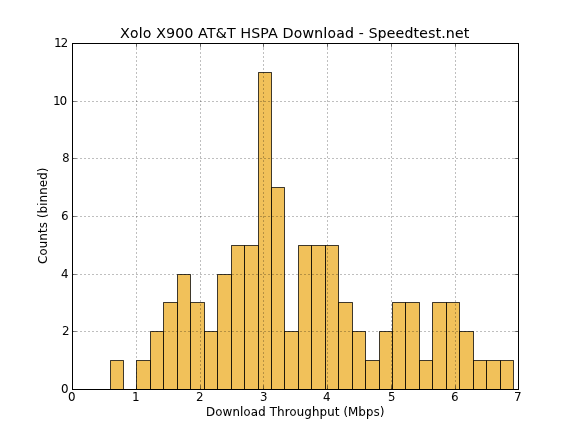
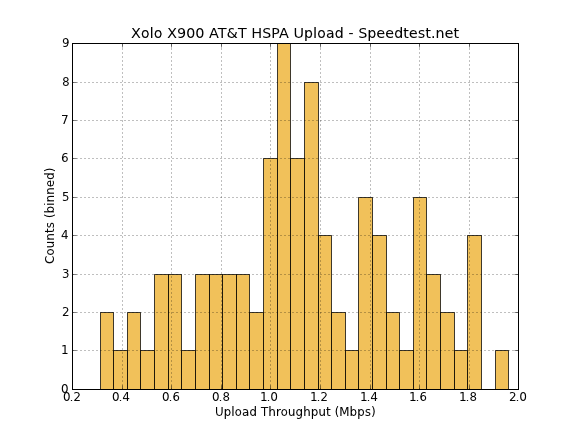
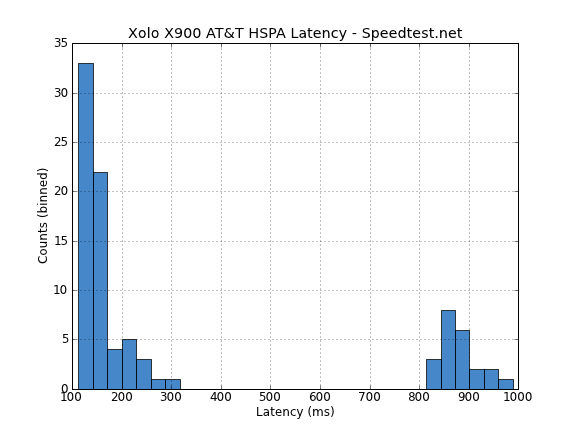
At this point HSPA+ 14.4 on AT&T is fairly well understood, running these is more validation that there’s nothing wrong with cellular on the device, and unsurprisingly there isn’t - again Intel knows how to implement its own baseband without issue, and with good performance.
WiFi
For WiFi and Bluetooth, the X900 uses a TI WiLink WL1271 series 6 combo chip which supplies 802.11b/g/n single spatial stream on 20 MHz channels with the short guard interval rate of 72 Mbps, and bluetooth 2.1 + EDR support. Some of the Intel documentation shows a TI WL1283 being used (which is WL 7.0 and includes a GPS baseband) and I don’t doubt that other Medfield platforms may implement WL128x or even WiLink 8 series with GNSS, however the X900 is definitely WL1271.
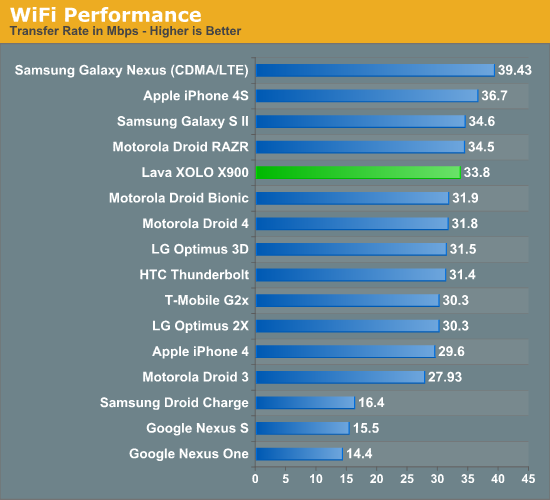
In our WiFi test which consists of a 100 MB PDF loaded over an 802.11n network, the WL1271 does pretty well, just as expected.
GPS
Like the TI WiLink series part, it seems that some Medfield designs include the WiLink 7 series with a GPS basbeand, and others include the more common SiRF Star 4 GSD4t GPS which we have seen in a ton of different smartphones, again including many Samsung phones.

I have no complaints with the GPS lock speed or quality on the X900, it’s speedy and accurate, and works well. I navigated around town with the device and never encountered any problems.
NFC
The X900 also includes NFC support, courtesy the ubiquitous NXP PN544 controller. The smartphone also includes the stock tag reader application, though NFC ships disabled. I tested it on the NFC tag sent with the Nexus S an eternity ago and it worked perfectly.

It’s safe to assume that with the Android 4.0 update beaming will be enabled.
Voice and Speakerphone
The X900 includes some common mode noise suppression components, including a primary and secondary microphone and an Audience eS305 voice processor.
We’ve seen the A102x series in devices before, including the Nexus One, iPhone 4, and numerous other popular smartphones. The reality is that good noise rejection so the far end hears nothing of the ambient sound around you is important both for making calls sound better, and also for increasing the idle or blanking periods on the reverse link. The X900 is my first time hearing the eS305 in action, and to test we did what we normally do by placing a call in front of some speakers, increasing volume, and speaking into the handset while recording the call on the far end on another handset.
I can’t emphasize enough that during the most taxing parts of this recording, I cannot hear myself speak at all. eS305’s performance is great, just like we’ve seen with their other solutions in devices where we’re able to identify its presence. The reality is also that using an array of microphones and some common mode noise rejection is basically the status quo for a high end smartphone right now.
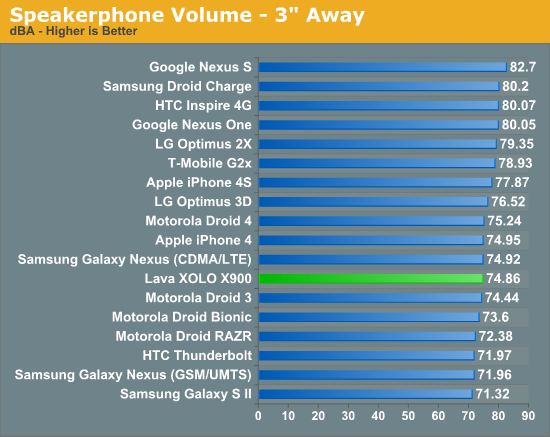
Speakerphone on the X900 is split between the two bottom speaker jacks, and isn't quite as loud as I'd like. We measured as usual with an Extech digital sound data logger 3 inches above the device.


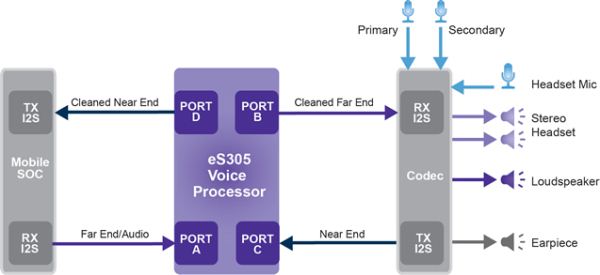








106 Comments
View All Comments
superPC - Thursday, April 26, 2012 - link
Well this atom only has 1/4 of conroe dual core transistor count right now. a move to 22nm could bring conroe level performance.Khato - Thursday, April 26, 2012 - link
Remember, conroe class performance simply indicates a general IPC level. I don't expect something on par with an E8600, more like a SU9600. It's quite feasible on the 22nm LP process, and actually is roughly in-line with the one Atom performance roadmap from awhile ago.extide - Wednesday, April 25, 2012 - link
That wont be happening for a while, but from what I have heard 2013 will bring us a second gen (out-of-order) atom on a mature 22nm process. We should see 2Ghz+ clockspeeds and 2 cores, plus a healthy IPC boost. This is going to be an exciting battle to watch, the old Intel vs AMD gig is kind of stale, so its awesome to see a real challenge for Intel again!A5 - Wednesday, April 25, 2012 - link
ULV Haswell will have a TDP an order of magnitude too high for a phone form factor. Tablets, maybe.MonkeyPaw - Wednesday, April 25, 2012 - link
"We waited years for Intel's first smartphone, now the question is how long do we have to wait for the first irresistable one?"It wont matter. Intel will dump millions into advertising, and every single phone maker will have ads for their new x86 phones, ending with the usual Intel chorus.
dougys - Wednesday, April 25, 2012 - link
I read somewhere else a few weeks back that the iPhone 5 could have Intel Inside. However, something else I read suggested that if they were to do this all the apps would have to be re-written... Does anyone have any thoughts/insight?tipoo - Wednesday, April 25, 2012 - link
Apple has a few architecture changes under its belt, but I very much doubt it, not for this chip. Apple bought chip design companies and spends more on internal chip design year after year for good reason.Not sure about iOS compatibility but this chip can run any Android apps just fine as the article points out through binary translation, I think Android apps use Java and iOS uses C++ though so I'm not sure if that would still work.
If Apple was to go to an outside design for its chips (which I highly doubt it will) I'd hope it would be for Qualcomm, Krait is amazing.
dcollins - Wednesday, April 25, 2012 - link
Apple will not move to an Intel chip anytime soon because they have been very successful in designing their own SoC. Just look at the battery life benchmarks: Apple crushes everyone in Hours/Watt*Hour. Plus, doing it in house gives them more flexibility on the overall design of their boards.There is a small chance of Intel manufacturing chips for Apple, but that is a long shot as well. Chips manufactured on Intel's 22nm 3d gate process would be incompatible with chips produced on competing 28nm processes (different physical size) and Apple is traditionally opposed to single sourcing crucial components.
tipoo - Wednesday, April 25, 2012 - link
Why does the GN get worse flash performance than the Nexus S and even Nexus One? That isn't a resolution dependant test, right?I'm also curious why the dual core Atrix barely does better than the single core Nexus S in Vellamo, was that just a bad SoC design or is it because it runs an older OS?
tipoo - Wednesday, April 25, 2012 - link
I also just got 915 on my Nexus S rather than 622, but I'm using an unofficial Cyanogenmod 9 build from XDA forums.